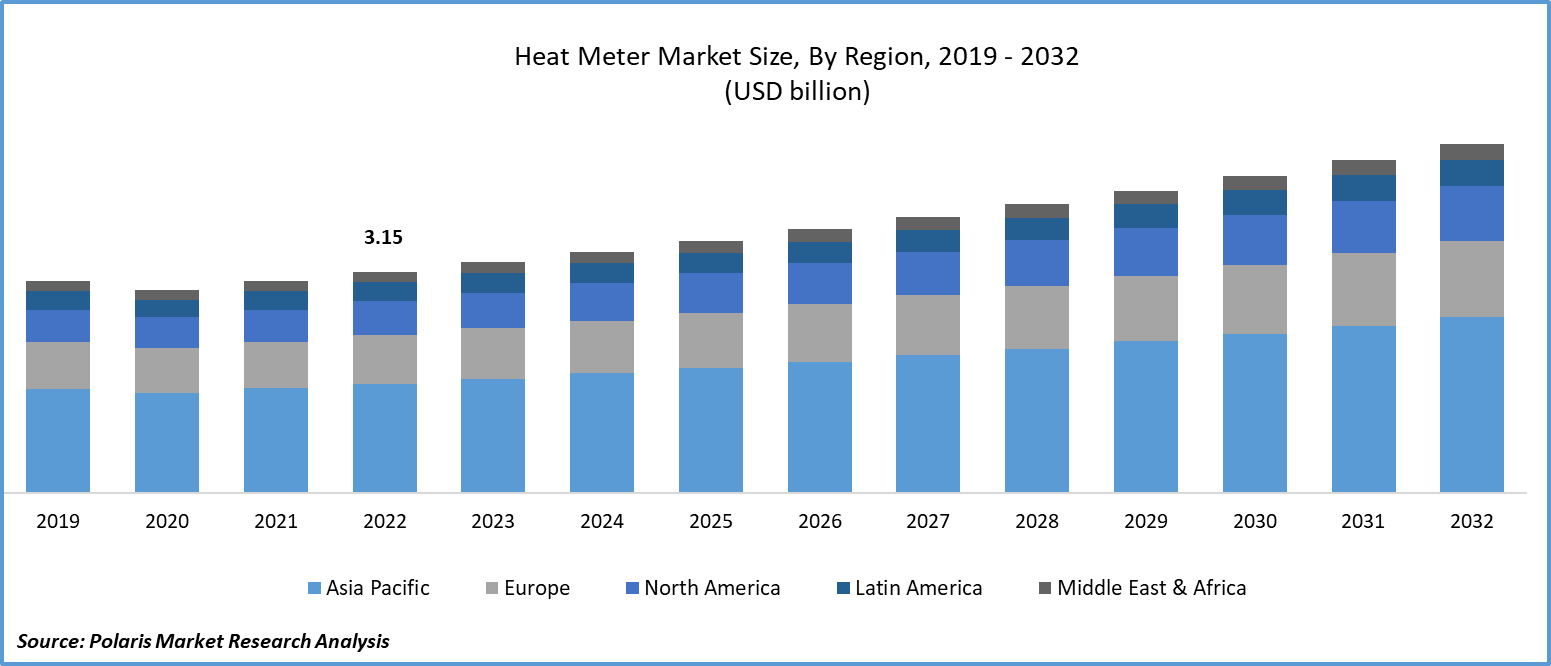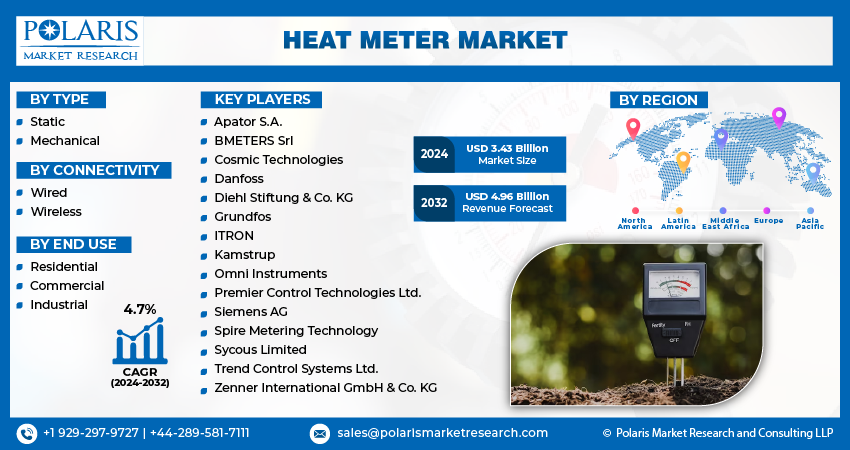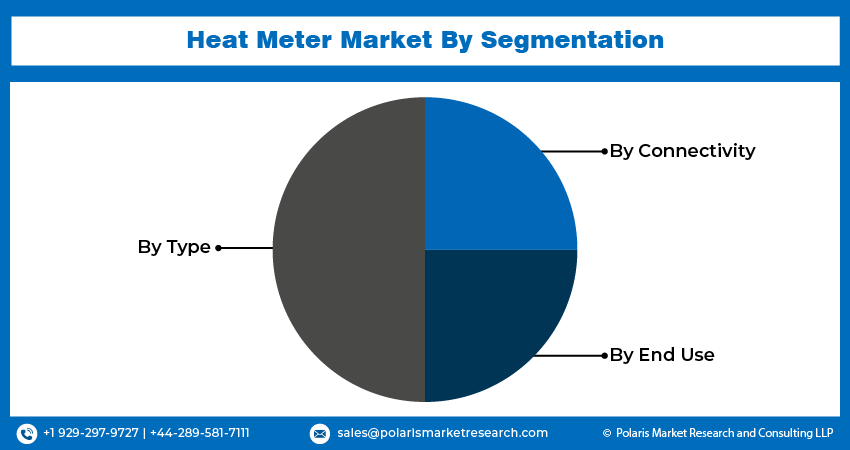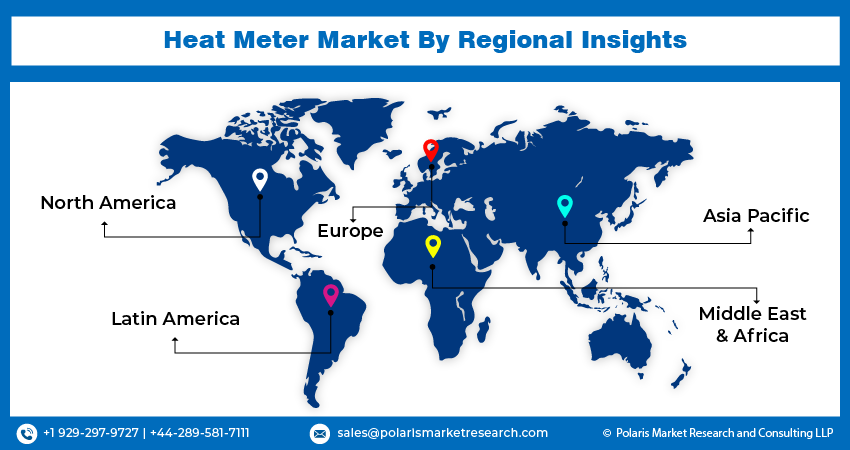
Heat Meter Market Share, Size, Trends, Industry Analysis Report, By Type (Static, Mechanical), By Connectivity (Wired, Wireless), By End-use (Residential, Commercial), By Region, And Segment Forecasts, 2024 - 2032
- Published Date:Jan-2024
- Pages: 118
- Format: PDF
- Report ID: PM4100
- Base Year: 2023
- Historical Data: 2019-2022
Report Outlook
The global heat meter market was valued at USD 3.28 billion in 2023 and is expected to grow at a CAGR of 4.7% during the forecast period.
The market is propelled by the rising need for energy-efficient solutions, governmental policies encouraging energy conservation, a strong emphasis on sustainable practices, and the increasing uptake of district heating systems. Additionally, technological advancements like smart metering and IoT integration play a vital role in market expansion by offering precise and efficient measurements of heat consumption. Effective energy management is a paramount concern for organizations today. Heat meters provided by companies such as Kamstrup and Sontex enable precise measurement and control of energy usage, addressing this critical need.
Heat metering systems calculate the aggregate of heat energy taken in by a building or facility. They offer precise and dependable data on energy intake and are an important instrument for handling energy productivity, lessening prices, and encountering justifiable objectives. When amalgamated as a segment of the brazen metering solution, this permits energy observation of prevalent and historic usage. Energy metering can assist consumers in better handling their energy usage, lessen the prices, and sanction they only enact for the heating and the hot water they utilize.
Truncated power utilization is important in heat cost earmarking. The heat meter market sales are soaring as large-scale battery life decreases utilities' total cost of ownership across a handful of substitutions and site visits. As with the majority of battery-fuelled smart metering requisitions, elongated wireless scope and elevated dependability sanction exhaustive association in all sites and situations, lessening sustenance prices and escalating consumer contentment.

To Understand More About this Research: Request a Free Sample Report
Many projects focus on improving energy efficiency by the centralized heating services, necessitating precise measurement of the heat consumption. The smart buildings and smart city initiatives in the U.S. encourage the uptake of advanced metering systems, such as smart heat meters, enabling remote monitoring, data analysis, and effective energy management. Additionally, incentive programs and subsidies offered by federal governments to promote the energy conservation & clean energy solutions. The demand for these meters is driven by increased corporate awareness of the benefits of monitoring and controlling heat usage in commercial and industrial contexts.
Growth Drivers
Increasing Demand for Energy Efficiency
Moreover, the grid's complexity has heightened due to increased electrical demand, new regulations, and the integration of sustainable energy sources. Smart heat meters offer various benefits, including detecting energy theft, minimizing business losses, and enhancing revenue management. Customers utilizing these meters can monitor their energy usage and reduce wastage. These factors are expected to drive market expansion in the coming years. For instance, a study by the International Energy Agency revealed that the Americas region experienced a 2.3% increase in energy consumption in 2022.
Furthermore, power consumption in the U.S. saw a 2.6% increase in 2022; however, projections indicate a 0.6% decline in demand for 2023, followed by an average rise of 1.2% in 2024 and 2025. Throughout this forecasted period, the escalating power demand in the U.S. is expected to drive heat meter market growth. As energy consumption rises, accurate measurement and management of heat usage become increasingly vital, especially in applications like residential and commercial heating systems. Heat meters play a pivotal role in advancing energy efficiency and sustainability by offering precise measurements, facilitating improved energy management, and promoting responsible consumption practices.

Report Segmentation
The market is primarily segmented based on type, connectivity, end use, and region.
|
By Type |
By Connectivity |
By End Use |
By Region |
|
|
|
|
To Understand the Scope of this Report: Speak to Analyst
By Type Analysis
Static Segment Held the Largest Share in 2022
Static segment dominated the market. Static heat meters are devices utilized to measure thermal energy exchanged in heating or cooling systems, devoid of moving parts. They typically incorporate sensors like temperature and flow sensors to gauge the temperature difference and flow rate of the heating or cooling medium. These measurements are then utilized to calculate the transferred thermal energy. Static heat meters are renowned for their precision, reliability, and minimal maintenance needs, making them ideal for applications demanding accurate heat measurement, such as district heating systems or individual building heating systems. These attributes are expected to drive market growth in the foreseeable future.
Mechanical heat meters expected to grow at the fastest pace. These meters commonly feature a mechanical flow sensor to measure the flow rate of the heating or cooling medium, coupled with a mechanical temperature sensor for assessing temperature differences. The motion of these components translates into measurements of thermal energy exchange. Although mechanical heat meters have been traditionally prevalent, static heat meters are increasingly favored due to their benefits, including enhanced accuracy, reliability, and reduced maintenance requirements.
By Connectivity Analysis
Wired Segment Accounted for the Largest Market Share in 2022
Wired segment accounted for the largest market share. Wired heat meters are commonly integrated into building automation systems, enabling centralized monitoring and control of heating or cooling energy consumption. In industrial or commercial contexts, these meters can be integrated into comprehensive energy management systems, offering real-time data to optimize energy usage. Additionally, the wired connections facilitate remote monitoring of heat meters, enabling efficient management and troubleshooting without requiring physical access to the meters. Essentially, a wired heat meter system utilizes physical wires or cables to transmit data and information.
By End Use Analysis
Residential Segment Held the Most Significant Market Revenue Share in 2022
Residential segment held a significant market share. Heat meters in residential applications measure the heat energy consumed for heating, often used alongside heating systems for monitoring and billing purposes. Additionally, residents and building managers can utilize these meters to monitor and optimize heating systems for efficiency. In commercial settings, heat meters are pivotal in monitoring and managing energy consumption specifically for heating needs. They provide essential data for making informed decisions that enhance overall energy efficiency, especially in HVAC systems.
Commercial buildings segment expected to grow at significant pace. In the realm of commercial buildings, adherence to energy efficiency and environmental sustainability regulations is paramount. Heat meters prove invaluable in this regard by offering precise data for reporting, ensuring compliance with these regulations. In industrial contexts, heat meters are pivotal for monitoring and controlling energy consumption in diverse processes. They are employed to regulate fluid temperatures in industrial operations, guaranteeing the maintenance of optimal temperature levels for heightened efficiency. Given the intricate heating systems in industrial facilities, the role of heat meters becomes even more crucial.

Regional Insights
North American Region Accounted for the Largest Share in 2022
North America held the largest share. The region places a growing emphasis on energy efficiency, where heat meters play a pivotal role in optimizing energy consumption within heating systems. Moreover, the focus on environmental sustainability and the imperative to reduce carbon emissions have spurred the adoption of technologies like heat meters, enhancing energy management practices. The increasing integration of renewable energy sources has further emphasized the need for precise heat measurement, thereby boosting the demand for advanced heat metering technologies.
MEA will grow at the significant pace. In the UAE, especially in Dubai and Abu Dhabi, rapid urbanization and infrastructure growth have spurred the construction of numerous residential and commercial buildings. Emphasizing sustainable development and energy efficiency, governments in the region have introduced regulations and initiatives encouraging the adoption of advanced technologies like heat meters. These devices are employed to monitor and enhance energy efficiency in heating systems. Additionally, the region's dedication to diversifying its energy sources, including renewable energy, highlights the critical role of accurate heat measurement.

Key Market Players & Competitive Insights
Prominent manufacturers employ diverse strategies, including global expansions, introducing new products, and engaging in mergers and acquisitions, to enhance their market presence and adapt to evolving technical requirements.
Some of the major players operating in the global market include:
- Apator S.A.
- BMETERS Srl
- Cosmic Technologies
- Danfoss
- Diehl Stiftung & Co. KG
- Grundfos
- ITRON
- Kamstrup
- Omni Instruments
- Premier Control Technologies Ltd.
- Siemens AG
- Spire Metering Technology
- Sycous Limited
- Trend Control Systems Ltd.
- Zenner International GmbH & Co. KG
Recent Developments
- In April 2022, Kamstrup & Thvilum A/S have formed a partnership, enabling Kamstrup to expand its support for Danish utilities. Through this collaboration, utilities can enhance their decision-making by leveraging factual knowledge, a vital component in seizing digital opportunities.
- In September 2023, Itron Inc. collaborated with the Jordan Electric Power (JEPCO) to boost their digital transformation efforts. JEPCO is implementing the Itron Enterprise Edition Meter Data Management system to streamline business processes and centralize data management.
Heat Meter Market Report Scope
|
Report Attributes |
Details |
|
Market size value in 2024 |
USD 3.43 billion |
|
Revenue forecast in 2032 |
USD 4.96 billion |
|
CAGR |
4.7% from 2024 – 2032 |
|
Base year |
2023 |
|
Historical data |
2019 – 2022 |
|
Forecast period |
2024 – 2032 |
|
Quantitative units |
Revenue in USD billion and CAGR from 2024 to 2032 |
|
Segments covered |
By Type, By Connectivity, By End Use, By Region |
|
Regional scope |
North America, Europe, Asia Pacific, Latin America, Middle East & Africa |
|
Customization |
Report customization as per your requirements with respect to countries, region, and segmentation. |
